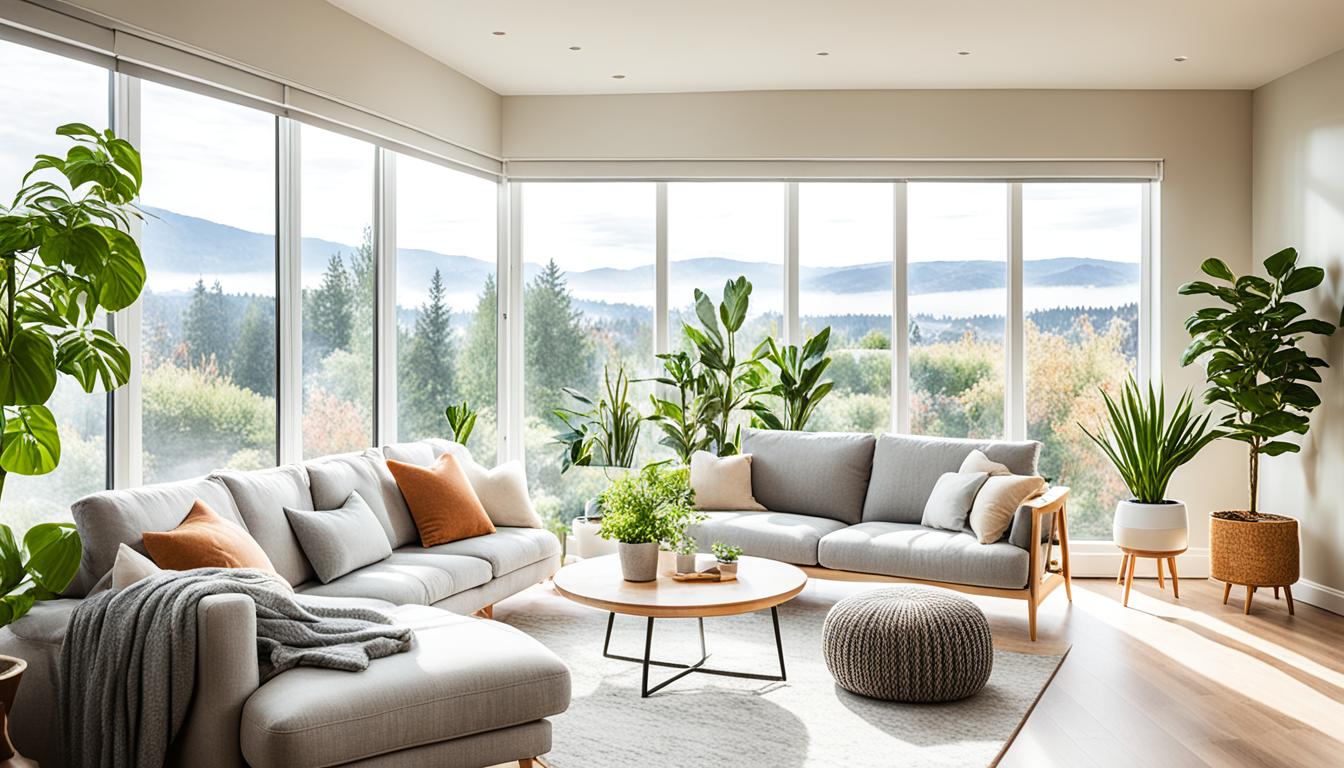Designing a Chronic Illness-Friendly Living Space
For over a decade, I have been on a journey as a loving partner to a woman with chronic illnesses, but before I get to my rather short story, let me answer – Why designing a chronic illness-friendly living space is important?
Designing a chronic illness-friendly living space is crucial to enhance the quality of life for individuals facing ongoing health challenges. It promotes accessibility, safety, and comfort, facilitating daily tasks and reducing stressors, thereby promoting overall well-being and independence.
My wife’s battle with endometriosis and fibromyalgia has not only shaped me into the man I am today but has also ignited my passion for creating accessible and chronic illness-friendly living spaces. Witnessing firsthand the challenges she faces daily, I have learned the importance of designing a home that caters to her specific needs.
This experience has inspired me to start a blog, where I share our story and the knowledge I have gained along the way, making it therapeutic for me and an opportunity to advocate for my wife’s well-being. Through blogging, I have also been able to explore ways to secure our future financially, bringing a sense of stability amidst the uncertainty of living with chronic illness.
- The Importance of Designing for Chronic Illness-Friendly Living Space
- Individualizing Home Design for Chronic Illness
- Key Considerations for Home Design
- Designing for Specific Chronic Illnesses: Arthritis
- Designing for Specific Chronic Illnesses: Dementia/Alzheimer's
- Designing for Specific Chronic Illnesses: Chronic Pain
- Designing for Specific Chronic Illnesses: Cancer
- Designing for Specific Chronic Illnesses: Mental Health Disorders
- Designing for Specific Chronic Illnesses: Clinical Depression
- The Holistic Approach to Home Design
- Conclusion on Designing a Chronic Illness-Friendly Living Space
- Source Links
The Importance of Designing for Chronic Illness-Friendly Living Space
Living with a chronic illness presents numerous challenges that can impact an individual’s daily life. From managing symptoms to navigating barriers, individuals with chronic illnesses require a home environment that supports their unique needs. This is where the importance of designing for chronic illness comes in.
By incorporating accessibility into home design, individuals can experience immense benefits in terms of improving their quality of life. Accessibility features such as ramps, wider doorways, and grab bars can greatly enhance ease of movement and independence. These modifications not only minimize physical strain but also promote a sense of empowerment and autonomy.
Designing for chronic illness is not just about physical accessibility; it goes beyond that. It includes creating a supportive environment that takes into account the impact of the home on chronic illness management. This involves considering factors such as lighting, ventilation, and acoustics to optimize comfort and reduce stress and fatigue.
When designing for chronic illness, it is essential to understand the specific needs and challenges associated with each condition. For example, individuals with respiratory conditions may benefit from good air quality and allergen control measures, while those with mobility impairments require barrier-free living spaces that facilitate easy movement.
By designing homes that prioritize accessibility and cater to the unique requirements of chronic illnesses, individuals can experience an improved quality of life. A well-designed home environment can enhance overall well-being, promote self-care, and even contribute to better management of the chronic condition.
Remember, the impact of the home environment on chronic illness management should not be underestimated. Designing a home that incorporates accessibility features and promotes comfort and independence can truly make a difference in the lives of individuals with chronic illnesses.
The Impact of Home Environment on Chronic Illness Management
The design of the home plays a significant role in the management of chronic illness. Here are some ways in which the home environment can impact chronic illness management:
- Accessibility: A well-designed home with accessibility features ensures individuals can navigate their space without barriers or limitations. This promotes independence and reduces the risk of accidents or injuries.
- Comfort: The design of the home can greatly impact an individual’s comfort level. From ergonomic furniture to temperature control, creating a comfortable environment can alleviate symptoms and enhance well-being.
- Stress Reduction: A supportive home environment that minimizes stress triggers, such as noise or clutter, can help individuals better manage their chronic condition. Designing spaces that promote relaxation and calmness can contribute to stress reduction.
- Efficiency: A well-designed home can streamline daily routines and tasks, making them more manageable for individuals with chronic illnesses. From kitchen layouts to storage solutions, efficiency in design can save time and energy.
Designing for chronic illness goes beyond aesthetics. It is a deliberate and thoughtful process that takes into consideration the unique needs and challenges faced by individuals with chronic conditions. By incorporating accessibility into home design and optimizing the home environment for comfort and functionality, we can truly improve the quality of life for those living with chronic illness.
| Accessibility | Comfort | Stress Reduction | Efficiency |
|---|---|---|---|
| Wider doorways for wheelchair access | Ergonomic furniture for pain relief | Quiet spaces for relaxation | Accessible storage solutions |
| Ramps for easy mobility | Temperature control options | Minimizing clutter | Smart home technology for automation |
| Grab bars in bathrooms | Soft and supportive materials | Natural lighting for mood enhancement | Thoughtful layout for ease of movement |
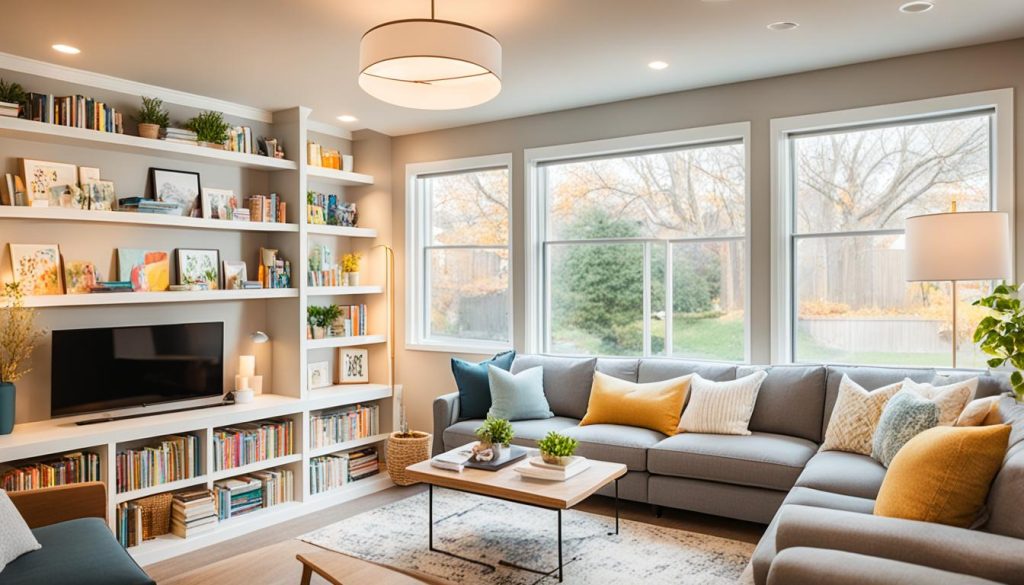
Individualizing Home Design for Chronic Illness
Living with a chronic illness presents unique challenges that require custom modifications to your home environment. By adapting your living space to your specific needs, you can create a personalized and comfortable home that supports your well-being.
When individualizing home design for chronic illness, it is important to consider factors such as your routines, mobility limitations, and personal preferences. By taking these aspects into account, you can make modifications that address the daily struggles and limitations caused by your condition.
For example, if you have mobility issues, you may need to modify your home with features such as ramps, grab bars, or widened doorways to improve accessibility and ensure ease of movement. Similarly, if your condition requires frequent rest or specific resting positions, you can personalize your furniture choices to accommodate these needs.
Remember, your home should be a sanctuary that supports your physical and emotional well-being.
By individualizing your home design for chronic illness, you can create a space that caters to your unique needs and promotes a sense of comfort and independence. Remember, every small modification can make a significant difference in your daily life.
| Considerations for Individualizing Home Design | Examples of Custom Modifications |
|---|---|
|
|
|
|
Key Considerations for Home Design
When designing a home for individuals with chronic illness, there are several key considerations that need to be addressed. These factors play a crucial role in creating a safe, accessible, and comfortable living environment that optimizes functionality and promotes overall well-being.
Accessibility
Accessibility is a top priority when designing for chronic illness. It involves removing barriers and creating spaces that can be easily navigated by individuals with mobility limitations. Widening doorways, installing ramps, and incorporating grab bars and handrails are some of the modifications that can enhance accessibility in the home.
Safety
Safety is another important aspect to consider. Designing with safety in mind helps minimize accidents and injuries. This may include installing security systems, providing adequate lighting both indoors and outdoors, and using slip-resistant flooring materials to reduce the risk of falls.
Functionality
Functionality refers to the practicality and efficiency of the home’s design. It involves optimizing the layout and organization of spaces to accommodate the specific needs of individuals with chronic illnesses. Considerations such as ease of movement, the proximity of essential items, and the availability of assistive devices should be taken into account.
Comfort
Comfort is essential for individuals with chronic illness as it can significantly impact their overall well-being. Designing for comfort involves choosing appropriate furniture, creating spaces for relaxation, and incorporating ergonomic elements. Selecting comfortable seating, adjustable beds, and utilizing soft textiles can help enhance comfort in the home.
By carefully considering these key considerations for home design, individuals with chronic illness can enjoy a living space that supports their unique needs and enhances their quality of life.
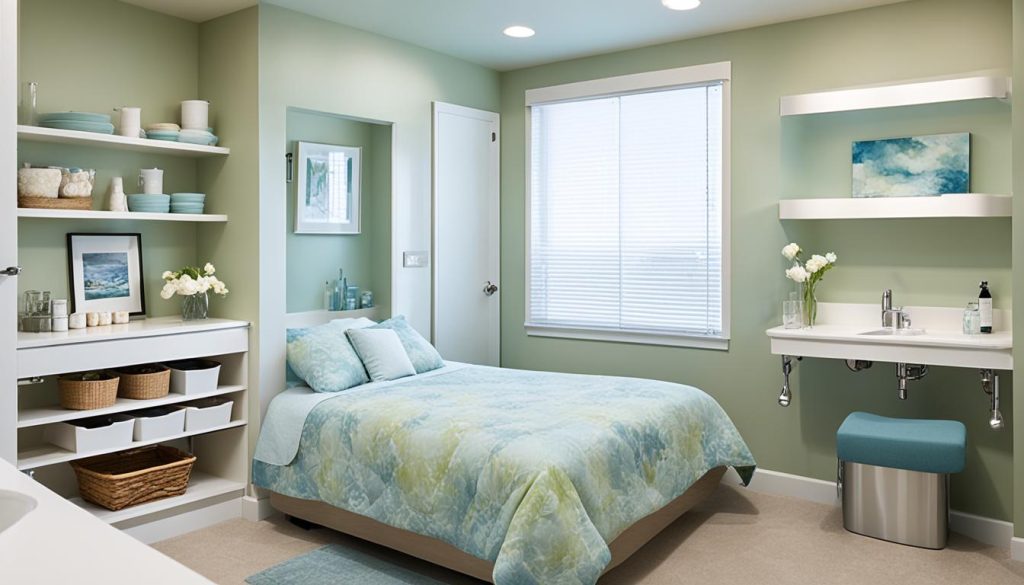
Designing for Specific Chronic Illnesses: Arthritis
When it comes to designing a home for individuals with arthritis, specific modifications are necessary to accommodate their unique needs. By implementing these home modifications, you can create an arthritis-friendly living space that enhances comfort and functionality for individuals with arthritis.
- Adjust the height of countertops and appliances to reduce the strain on joints.
- Create ample seating areas throughout the home to provide frequent rest opportunities.
- Install grab bars in bathrooms and other areas to improve stability and prevent falls.
- Use slip-resistant flooring to minimize the risk of slips and falls.
- Incorporate ergonomic kitchen tools, such as easy-grip utensils and jar openers, for increased convenience and reduced pain during daily tasks.
These modifications not only improve accessibility but also enhance daily living and manage pain for individuals with arthritis. Creating an environment that supports their mobility limitations allows them to maintain their independence and enjoy a more comfortable lifestyle.
| Home Modifications for Arthritis | Benefits |
|---|---|
| Adjustable Countertops and Appliances | Reduces strain on joints and facilitates ease of use. |
| Ample Seating Areas | Provides frequent rest opportunities and reduces fatigue. |
| Grab Bars | Improves stability and prevents falls, especially in bathrooms. |
| Slip-Resistant Flooring | Minimizes the risk of slips and falls. |
| Ergonomic Kitchen Tools | Reduces pain and discomfort during daily tasks, such as cooking and food preparation. |
Designing for Specific Chronic Illnesses: Dementia/Alzheimer’s
Individuals with dementia or Alzheimer’s require a home environment that supports their cognitive function, reduces confusion, and promotes safety.
Designing a dementia-friendly living space is essential to ensure the well-being and independence of those living with these conditions. Here are some key elements to consider when adapting the home for individuals with dementia…
1. Clear Signage
Implementing clear and visible signage throughout the home can help individuals with dementia navigate their surroundings more easily. Use large, contrasting fonts and color-coded signs to indicate different rooms or areas of the house.
2. Ample Lighting
Good lighting is crucial in a dementia-friendly home. Adequate lighting can reduce shadows and help individuals with dementia distinguish objects and surfaces. Natural light is the best option, but if that’s not possible, ensure bright and even lighting throughout the home.
3. Visual Cues
Using visual cues can be extremely helpful for individuals with dementia. Consider placing recognizable images or symbols on doors and drawers to aid memory and encourage independence.
4. Simple and Accessible Storage
Simplify storage solutions by using clear labels and organizing items in easily accessible locations. This not only reduces frustration but also promotes a sense of familiarity and ease in daily tasks.
5. Reminiscence Materials
Include elements that evoke positive memories and promote emotional well-being. This can range from displaying family photographs to incorporating personal mementos and familiar objects in the home environment.
Incorporating these design elements can promote safety, familiarity, and independence within the home for individuals with dementia or Alzheimer’s. Creating a nurturing and dementia-friendly living space is crucial for their well-being and overall quality of life.
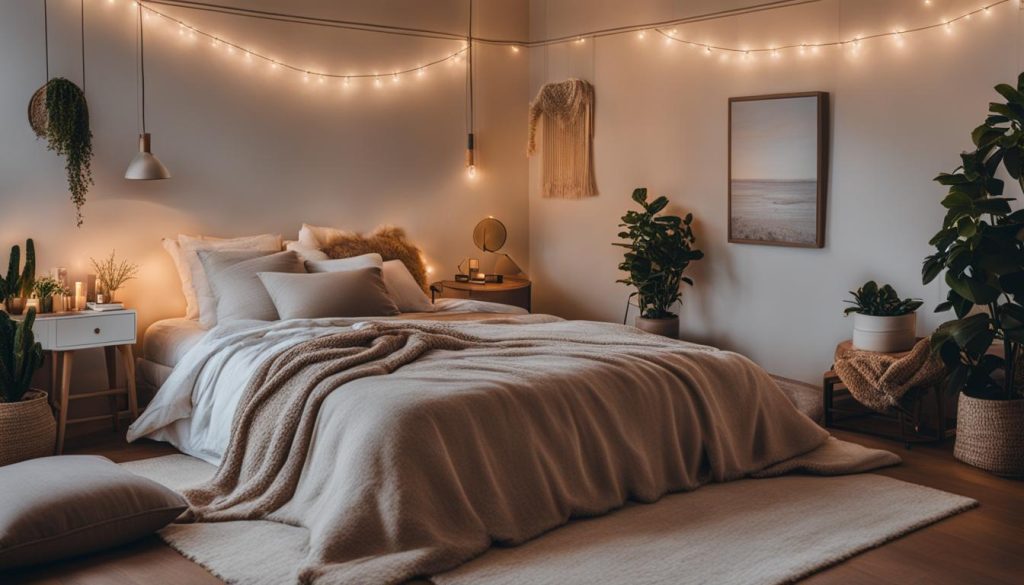
Designing for Specific Chronic Illnesses: Chronic Pain
Living with chronic pain can be challenging, but adapting your home to create a pain-friendly living space can make a significant difference in your daily comfort and well-being. By incorporating ergonomic design principles and making specific home modifications, you can optimize your home environment for chronic pain management.
Creating a Pain-Friendly Living Space
When designing your home for chronic pain, it’s important to focus on creating a space that minimizes physical strain and provides maximum comfort. Here are some key considerations:
- Adjustable Furniture: Invest in furniture that can be easily adjusted to accommodate your changing needs. Adjustable beds, chairs, and desks allow you to find the most comfortable positions and avoid unnecessary pain.
- Temperature Control: Maintain a comfortable temperature in your home by using devices such as programmable thermostats or personal cooling and heating systems. This helps alleviate pain associated with temperature sensitivity.
- Ergonomic Designs: Choose seating and sleeping arrangements that provide proper support and alignment for your body. Look for chairs with lumbar support, ergonomic keyboards, and adaptive mattresses that relieve pressure points.
- Soft and Supportive Materials: Opt for furniture and accessories made from soft and supportive materials to reduce pressure on sensitive areas. Consider using foam cushions, memory foam mattresses, or pillows specifically designed for pain relief.
By incorporating these elements into your home design, you can mitigate physical discomfort and create a pain-friendly environment that promotes relaxation and well-being.
Adapting the Home for Individuals with Chronic Pain Conditions
When adapting your home for chronic pain, it’s essential to tailor the modifications to your specific needs and limitations. Consider the following:
- Accessibility: Ensure your home is accessible by removing physical barriers and obstacles. Install ramps or handrails where necessary, and widen doorways to accommodate mobility aids such as wheelchairs or walkers.
- Lighting: Adequate lighting is crucial for individuals with chronic pain. Use a combination of natural and artificial lighting to create a well-lit space that minimizes eye strain and enhances visibility.
- Color Scheme: Choose a soothing color palette for your walls and décor. Soft, neutral tones can help create a calming atmosphere and reduce visual distractions that could exacerbate pain.
- Organization and Storage: Keep your belongings organized and easily accessible. Use storage solutions that minimize bending, reaching, or twisting, reducing the risk of further discomfort.
By adapting your home to meet your specific chronic pain needs, you can improve mobility, reduce pain triggers, and regain control over your daily activities.
Designing for Specific Chronic Illnesses: Cancer
When individuals undergo cancer treatment, creating a home environment that promotes healing, comfort, and tranquility is essential for their overall well-being. By incorporating specific home design considerations, you can provide a space that supports their physical and emotional needs.
Home Design Considerations for Cancer Patients
When designing a home for cancer patients, it’s important to prioritize their comfort and safety. Consider the following:
- Choose natural materials: Incorporate elements such as wood, stone, and organic fabrics to create a soothing and inviting atmosphere.
- Optimize lighting: Use soft and warm lighting to create a calming ambiance. Consider incorporating dimmer switches or adjustable lighting fixtures to adapt to different needs and moods.
- Create soothing colors: Use gentle and neutral color palettes that promote relaxation and tranquility. Avoid bright or stimulating colors that may cause discomfort.
- Select comfortable furniture: Choose furniture that is supportive, comfortable, and easy to maneuver. Consider options with adjustable features that can accommodate individual preferences and physical limitations.
- Design spaces for relaxation: Create designated areas for relaxation, meditation, and self-care. This can include a cozy reading nook, a peaceful garden space, or a spa-like bathroom.
By incorporating these home design considerations, you can create a healing environment that promotes comfort and tranquility for individuals undergoing cancer treatment.
Designing for Specific Chronic Illnesses: Mental Health Disorders
Individuals with mental health disorders require a home environment that supports their emotional well-being and promotes calmness. Creating a supportive and nurturing living space can significantly impact their mental health and overall quality of life. Here are some key considerations for designing a home that caters to individuals with anxiety, depression, or other mental health disorders:
- Promoting Calm: Incorporate soothing colors, such as soft blues and greens, to create a tranquil atmosphere in your home.
- Natural Elements: Bring nature indoors by incorporating plants and natural materials like wood and stone. Connecting with nature can have a calming effect on mental health.
- Relaxation Spaces: Dedicate areas in your home for relaxation and self-care activities. Consider creating a cozy reading nook or a meditation corner to promote relaxation and mindfulness.
- Adequate Privacy: Design your home to provide sufficient privacy, allowing individuals with mental health disorders to have personal space where they can feel safe and secure.
By designing your home with mental health in mind, you can create a supportive environment that enhances emotional well-being and promotes a sense of calm and well-being.
Designing for Mental Health Disorders – Key Considerations
| Consideration | Description |
|---|---|
| Promoting Calm | Incorporate soothing colors, such as soft blues and greens, into your home design to create a tranquil atmosphere. |
| Natural Elements | Bring nature indoors by incorporating plants and natural materials like wood and stone, which can have a calming effect on mental health. |
| Relaxation Spaces | Dedicate areas in your home for relaxation and mindfulness activities, such as a cozy reading nook or a meditation corner. |
| Adequate Privacy | Design your home to provide sufficient privacy, allowing individuals with mental health disorders to have personal space where they can feel safe and secure. |
Designing for Specific Chronic Illnesses: Clinical Depression
Living with clinical depression can be challenging, but creating a home environment that promotes well-being and uplifts your mood can make a significant difference in your daily life. By considering specific home design considerations for individuals with depression, you can create a space that supports your emotional well-being and helps alleviate symptoms.
To create a mood-lifting environment in your home, incorporate natural light as much as possible. Open up curtains and blinds during the day to let in sunlight, which can positively impact your mood. Additionally, consider using bright colors in your interior design, such as vibrant wall paint, colorful décor, or cheerful artwork. These elements can help create a more positive atmosphere and enhance your overall well-being.
In addition to light and color, it’s essential to design spaces in your home that promote relaxation and self-care. Dedicate a specific area for activities like meditation, yoga, or reading. Fill this space with comfortable seating, calming colors, and natural elements like plants. Having a designated space for relaxation can provide a soothing retreat when you need to unwind and recharge.
Exercise and social interaction are also crucial for managing depression symptoms. Consider incorporating an exercise area in your home, whether it’s a small workout corner or a designated room for fitness equipment. Additionally, create inviting spaces, such as a cozy living room or a spacious dining area, where you can spend quality time with loved ones or engage in activities that bring you joy. Social connection and physical activity can both contribute to improving your mood and overall well-being.
By taking these considerations into account and customizing your home design to incorporate light, color, relaxation spaces, and areas for social interaction, you can create a home environment that supports your journey towards managing depression effectively.
Benefits of Designing for Clinical Depression:
- Promotes a positive and uplifting atmosphere
- Enhances overall well-being and mood
- Provides space for relaxation and self-care
- Encourages exercise and social interaction
| Design Considerations | Benefits |
|---|---|
| Incorporating natural light | Improves mood and boosts vitamin D levels |
| Using bright colors | Creates a positive and energetic environment |
| Designating relaxation spaces | Provides a calm retreat for stress reduction |
| Creating areas for exercise | Supports physical and mental well-being |
| Incorporating social spaces | Promotes social interaction and a sense of belonging |
The Holistic Approach to Home Design
A holistic approach to home design is essential for creating a nurturing environment that promotes overall wellness. By incorporating physical, emotional, and psychological well-being into the design process, you can transform your home into a space that supports your health and happiness.
When designing holistically, consider incorporating elements of biophilic design, which seeks to connect individuals with nature. This can be achieved by integrating natural materials, such as wood or stone, and incorporating ample natural light into your home. Biophilic design has been shown to improve mood, reduce stress, and enhance cognitive function.
In addition to biophilic design, consider incorporating elements that reflect your aesthetic preferences and personal hobbies and interests. Your home should be a reflection of who you are and should bring you joy. Whether it’s creating a dedicated space for your art studio or designing a cozy reading nook, incorporating elements that align with your passions can enhance your overall well-being.
Furthermore, pay attention to the layout and flow of your home. Consider how your daily activities and routines can be optimized for convenience and efficiency. Creating organized and functional spaces will promote a sense of calm and reduce stress.
Finally, think about the colors and textures used in your home. Colors have a profound impact on our emotions and can influence our mood. Opt for calming, soothing colors, such as blues and greens, in areas where you want to relax and unwind. Use soft textures, such as plush rugs or cozy blankets, to create a comforting atmosphere.
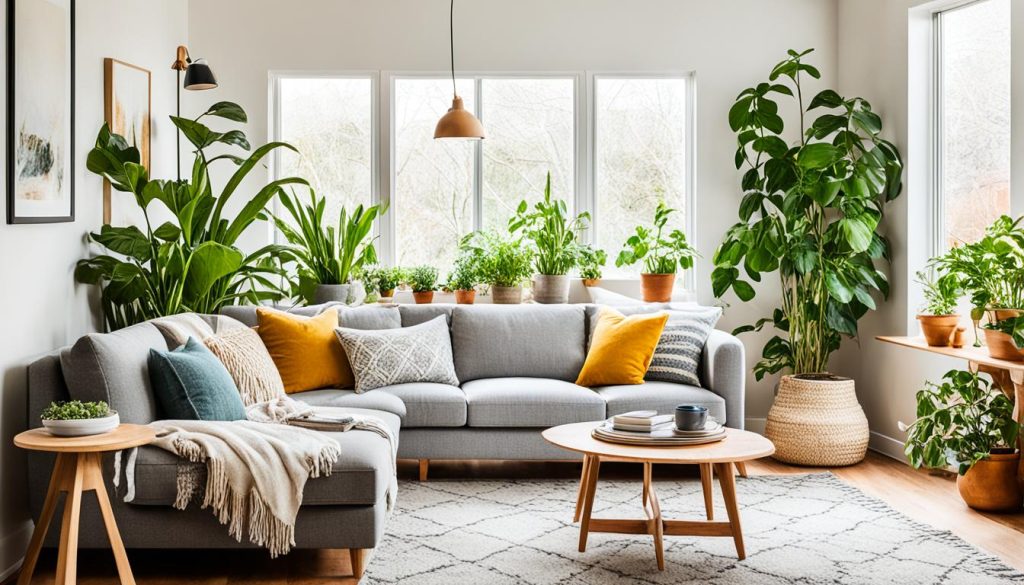
Benefits of a Holistic Approach to Home Design
- Promotes physical well-being by incorporating nature and optimizing layout for convenience.
- Enhances emotional well-being by creating spaces that reflect personal interests and brings joy.
- Supports psychological well-being by considering color psychology and creating a calming environment.
- Creates a nurturing and harmonious living space that promotes overall wellness.
A holistic approach to home design goes beyond aesthetics and incorporates elements that promote physical, emotional, and psychological well-being. By creating a nurturing environment, your home can become a sanctuary that supports your overall wellness.
| Physical Well-being | Emotional Well-being | Psychological Well-being |
|---|---|---|
| Integrating natural materials and ample natural light | Incorporating elements that reflect personal aesthetic preferences and hobbies | Considering color psychology and creating a calming environment |
| Optimizing layout for convenience and efficiency | Creating organized and functional spaces |
Conclusion on Designing a Chronic Illness-Friendly Living Space
Designing a chronic illness-friendly living space is essential for individuals with chronic conditions to maintain their independence, promote comfort, and enhance their overall quality of life. By incorporating accessibility features and personalizing the design to meet specific needs, the home becomes a supportive environment that enhances well-being.
The importance of personalized home design for chronic illness cannot be overstated. Each person’s experience with chronic illness is unique, and their home should reflect their specific challenges and limitations. By considering their daily routines, mobility, and personal preferences, the design can be tailored to create a safe, comfortable, and aesthetically pleasing living space.
Improving the quality of life through design adaptations is a transformative process. It involves creating an accessible home environment that accommodates the daily routines and limitations caused by chronic illness. The home should prioritize safety, functionality, and comfort, enabling individuals to navigate their living space with ease and minimizing the risk of accidents.
In conclusion, designing a chronic illness-friendly living space is not just about creating accessible and functional spaces, but also about promoting well-being and independence. By understanding the unique challenges faced by individuals with chronic illnesses and incorporating personalized design solutions, the home becomes a sanctuary that supports their physical, emotional, and psychological needs.


About Me
Hi, I’m Lucjan! The reason why I decided to create this blog was my beautiful wife, who experienced a lot of pain in life, but also the lack of information about endometriosis and fibromyalgia for men…
